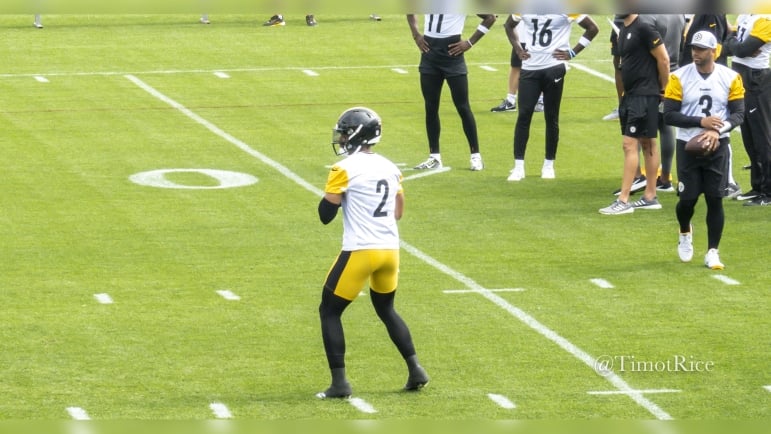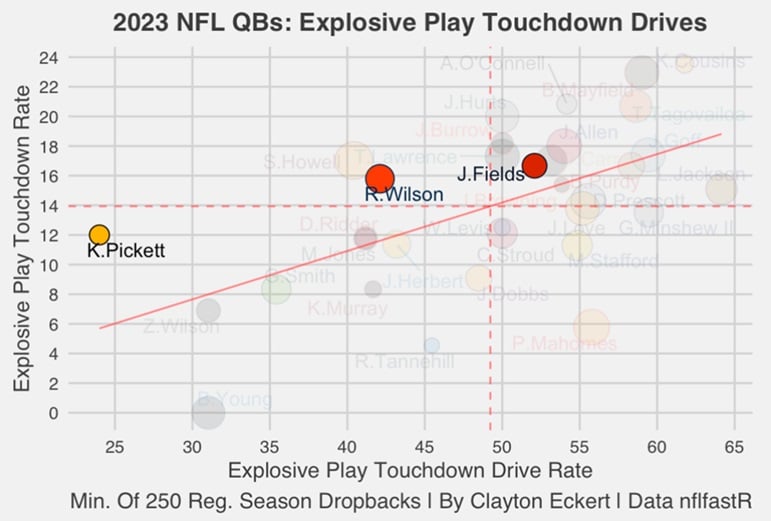Continuing this series, learning about new Pittsburgh Steelers quarterbacks Russell Wilson and Justin Fields, I wanted to dive deeper into an important aspect of successful offenses – explosive plays (20 yards or more). With training camp underway, Fields has displayed his explosive play ability with his arms and legs, a welcomed sight that’s been lacking at the position in Pittsburgh for some time now.
Today’s goal is to look at and provide data on this, what it may mean for the Steelers in 2024, and how explosive plays on QB drop backs (pass attempts, sacks, and scrambles) impacted the ultimate goal of scoring touchdowns.
I’ll discuss what percentage of explosive plays resulted in a touchdown drive (explosive play touchdown drive rate), and the rate of explosive plays that were touchdowns (explosive play touchdown rate) to add context to what point in the drive the big plays came on average.
Here are quarterbacks results in 2023 (min. of 250 regular season drop backs), highlighting the new QB room and former Steeler Kenny Pickett for comparison:
Right away we get visual evidence of my earlier point of Pittsburgh’s explosive play issues. Pickett was below-average in both data points, most miserably a 24.0 explosive play touchdown drive rate that was worst among the 33 qualifying QBs by far. Next to last was Bryce Young as a rookie at 31.0-percent, seven percentage points higher than Pickett. Ouch.
Pittsburgh struggled to score points in general in 2023, and this stat really shows the lack of explosive plays in the offense really hampered their attempts to reach the end zone.
We see Pickett’s better mark was a 12.0 explosive play touchdown rate, but still below the mean and ranking 22nd. More specifically, Pickett had 25 explosive plays on his drop backs (28th), only six explosive plays on touchdown drives (dead-last), and three explosive touchdowns (T-26th). Yes, he was injured and benched with just 363 drop backs last year (28th), but the rates on the visual really point to the lack of quality and it not being an issue of opportunities.
On the flip side, Fields was substantially better as an above the mean QB in both stats. His 52.1 explosive play touchdown drive rate ranked 16th, more than doubling Pickett’s number, along with a 16.7 explosive play touchdown rate that faired even better (T-12th).
On 457 drop backs (22nd), Fields tallied 48 explosive plays (T-14th), 25 on touchdown drives (T-13th), and eight explosive play touchdowns (T-ninth). While Fields has had his issues, the explosive element to his game would be a clear upgrade if/when he sees the field for the Black and Gold.
Pairing this with a similar Arthur Smith explosive touchdown drive study, where he got great results as an offensive coordinator with Tennessee, hopefully all this encouraging data points to a positive trend in explosive plays with Pittsburgh.
Wilson is still in pole position to be the Steelers starter as we sit here today, but has been out/limited due to a minor calf injury. He was also above-average among qualifiers with a 15.8 explosive play touchdown rate, just below Fields at 14th. So, both of the new quarterbacks in Pittsburgh were able to see explosive plays turn into touchdowns at an above-average rate last season. Music to the ears of Steelers fans.
Even though Wilson had a healthy number of total touchdowns last season (26, ninth-most), he landed below-average with a 42.1 explosive play touchdown drive rate (25th). Explosives didn’t lead to scoring as often as several of his peers last season, including Fields.
Here are Wilson’s totals that played into his rates: 530 drop backs (18th), 38 explosive plays (19th), 16 explosives on touchdown drives (T-21st), and six explosive touchdowns (17th).
As you may have expected, Fields may not be in pole position to be the starter, but is as the most explosive QB of the group. Wilson also provides it, but more as a passer in the latter stages of his career. And Pickett? Simply not good enough.
Here’s to hoping we see a much more explosive offense for the Black and Gold in 2024.









